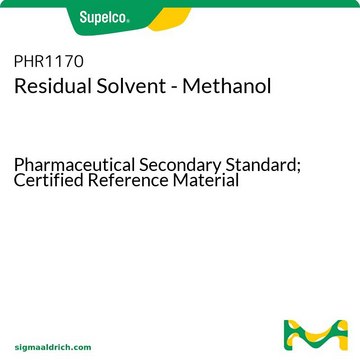Kluczowe dokumenty
82762
Methanol
analytical standard
Synonim(y):
Methyl alcohol
About This Item
Polecane produkty
klasa czystości
analytical standard
Poziom jakości
gęstość pary
1.11 (vs air)
ciśnienie pary
410 mmHg ( 50 °C)
97.68 mmHg ( 20 °C)
Próba
≥99.9% (GC)
Formularz
liquid
temp. samozapłonu
725 °F
okres trwałości
limited shelf life, expiry date on the label
granice wybuchowości
36 %
metody
HPLC: suitable
gas chromatography (GC): suitable
współczynnik refrakcji
n20/D 1.329 (lit.)
n20/D 1.329
bp
64.7 °C (lit.)
mp
−98 °C (lit.)
gęstość
0.791 g/mL at 25 °C (lit.)
Zastosowanie
environmental
Format
neat
ciąg SMILES
CO
InChI
1S/CH4O/c1-2/h2H,1H3
Klucz InChI
OKKJLVBELUTLKV-UHFFFAOYSA-N
Szukasz podobnych produktów? Odwiedź Przewodnik dotyczący porównywania produktów
Opis ogólny
Zastosowanie
Polecane produkty
Hasło ostrzegawcze
Danger
Zwroty wskazujące rodzaj zagrożenia
Zwroty wskazujące środki ostrożności
Klasyfikacja zagrożeń
Acute Tox. 3 Dermal - Acute Tox. 3 Inhalation - Acute Tox. 3 Oral - Flam. Liq. 2 - STOT SE 1
Organy docelowe
Eyes,Central nervous system
Kod klasy składowania
3 - Flammable liquids
Klasa zagrożenia wodnego (WGK)
WGK 2
Temperatura zapłonu (°F)
49.5 °F - closed cup
Temperatura zapłonu (°C)
9.7 °C - closed cup
Środki ochrony indywidualnej
Eyeshields, Faceshields, Gloves
Wykazy regulacyjne
Wykazy regulacyjne dotyczą głównie produktów chemicznych. Można w nich podawać ograniczoną liczbę informacji na temat produktów niechemicznych. Brak wpisu oznacza, że żaden ze składników nie znajduje się w wykazie. Użytkownik odpowiada za zagwarantowanie bezpiecznego i zgodnego z prawem stosowania produktu.
EU REACH Annex XVII (Restriction List)
Wybierz jedną z najnowszych wersji:
Masz już ten produkt?
Dokumenty związane z niedawno zakupionymi produktami zostały zamieszczone w Bibliotece dokumentów.
Klienci oglądali również te produkty
Produkty
The Utility of Headspace Grade Solvents for the Analysis of Organic Volatile Impurities
Protokoły
Separation of Acetone; Acetic acid; Propionic acid; Ethyl butyrate; Ethanol; Isoamyl acetate; Isobutyric acid; 3-Methyl-2-butanol; Methyl acetate; 1-Propanol; Acetal, ≥98%, FG; 2-Methyl-1-pentanol; Butyl acetate; Ethyl propionate; 3-Pentanol; 2-Pentanol, 98%; Ethyl isobutyrate; Isobutyl acetate; Acetaldehyde; Furfural; Butyric acid; Methanol; Ethyl acetate
GC Analysis of Class 2 Residual Solvents on OVI-G43
Nasz zespół naukowców ma doświadczenie we wszystkich obszarach badań, w tym w naukach przyrodniczych, materiałoznawstwie, syntezie chemicznej, chromatografii, analityce i wielu innych dziedzinach.
Skontaktuj się z zespołem ds. pomocy technicznej














